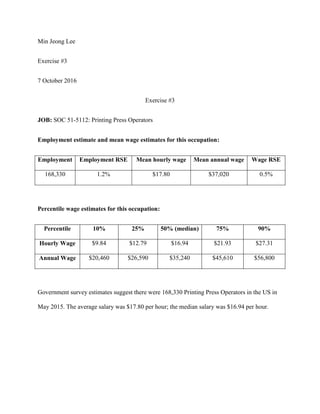
Job Worth
- 1. Min Jeong Lee Exercise #3 7 October 2016 Exercise #3 JOB: SOC 51-5112: Printing Press Operators Employment estimate and mean wage estimates for this occupation: Employment Employment RSE Mean hourly wage Mean annual wage Wage RSE 168,330 1.2% $17.80 $37,020 0.5% Percentile wage estimates for this occupation: Percentile 10% 25% 50% (median) 75% 90% Hourly Wage $9.84 $12.79 $16.94 $21.93 $27.31 Annual Wage $20,460 $26,590 $35,240 $45,610 $56,800 Government survey estimates suggest there were 168,330 Printing Press Operators in the US in May 2015. The average salary was $17.80 per hour; the median salary was $16.94 per hour.
- 2. Why do you think wages are reported on an hourly basis? Wages are a fixed regular payment, typically paid on a daily or weekly basis. Wages are reported on an hourly basis it can be used as a rough estimate to determine future salary, while a contract salary has many variables that could make it difficult to make the appropriate salary. What is the difference between the mean and the median? The mean is the average, where all the numbers are added up and then divided by the number of numbers. The median is the middle value in the list of numbers. To find the median, your numbers have to be listed from least to greatest. The mean wage is the average wage ($17.80). The median wage ($16.94) is the point at which half of workers earned more than that amount and half earned less. Most companies base pay on medians rather than means. Why might this be? Why would the median tend to be lower than the mean? Because median tends to be lower than the mean, most companies base their pay on medians. For Printing Press Operators, the median wage ($16.94) was lower than the mean wage ($17.80). Paying the median wage is cheaper for the company. Median is lower than the mean when there is a big difference between the numbers to the right of the median and the numbers to the left of the median. When implied, this means that the wages for employees are wide-ranged.
- 3. What is the ratio of the 90th percentile to the 10th percentile? What might explain this differential? What impact does it have on an organization’s decision about what to pay? The ratio of the 90th percentile to the 10th percentile is 27.31/9.84 = 2.78. The 90th percentile employee is paid 2.78 times more than the 10th percentile employee. There are many reasons for wage differentials. Credentials that show advanced education, professional certification, or licensure may determine wages. More experience and skill in a job field may earn an employee higher wages. Working conditions and training requirements may provide wage differentials. Individual tasks may vary in an occupation, involving more complex tasks and greater responsibility; these employees would be paid more. Geographic location may also be a factor in wage differential, because some areas have higher wages than that of other states for the same occupation. Success and performance also contribute to wage differentials because some employees are paid based on their performance. Now look at the different rates for various industries, states, and MSAs. (A MSA is a Metropolitan Statistical Area.) Do the different rates for different industries and localities help understand wage differentials for the same job? Depending on the industry and its location, there will be wage differentials for the same occupation. Some industries, such as agriculture, may affect certain areas more than others. Also, some occupations may be more important depending on the size of the company (ex. an investment banker at Goldman Sachs to that of a smaller company).
- 4. Do you think there are likely to be differentials within each industry or area? Why? There will most likely be more differentials within each area. Within each industry, it is likely that there are more similar skills needed for each job. However, in each area you must take into consideration the standard of living, which varies widely depending on where you live.